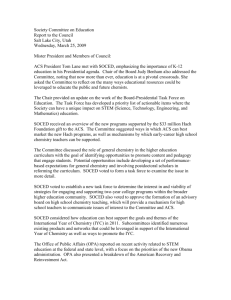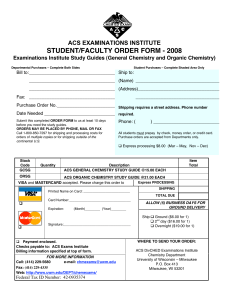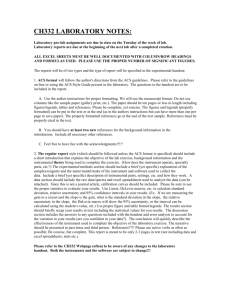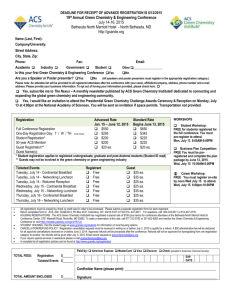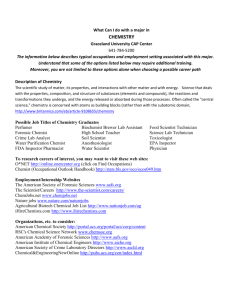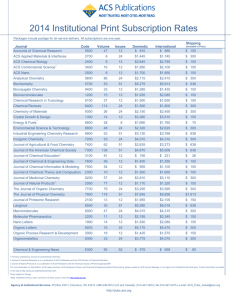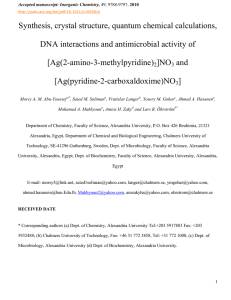Guide to Writing Scientific Laboratory Reports Chem 151L, Spring
advertisement
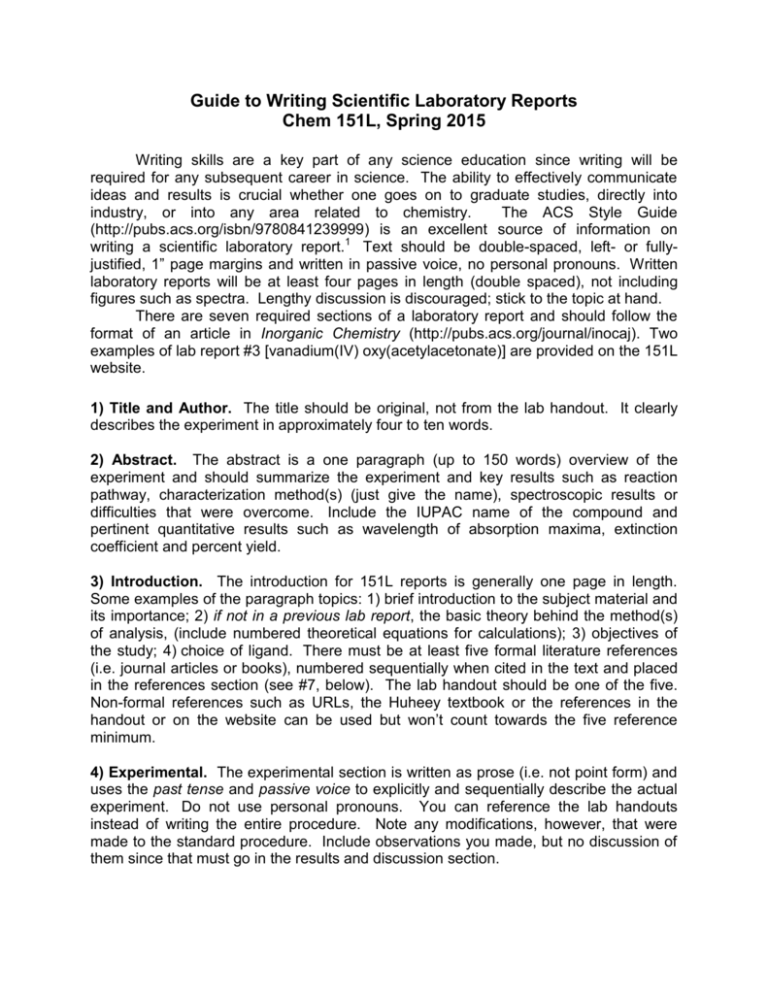
Guide to Writing Scientific Laboratory Reports Chem 151L, Spring 2015 Writing skills are a key part of any science education since writing will be required for any subsequent career in science. The ability to effectively communicate ideas and results is crucial whether one goes on to graduate studies, directly into industry, or into any area related to chemistry. The ACS Style Guide (http://pubs.acs.org/isbn/9780841239999) is an excellent source of information on writing a scientific laboratory report.1 Text should be double-spaced, left- or fullyjustified, 1” page margins and written in passive voice, no personal pronouns. Written laboratory reports will be at least four pages in length (double spaced), not including figures such as spectra. Lengthy discussion is discouraged; stick to the topic at hand. There are seven required sections of a laboratory report and should follow the format of an article in Inorganic Chemistry (http://pubs.acs.org/journal/inocaj). Two examples of lab report #3 [vanadium(IV) oxy(acetylacetonate)] are provided on the 151L website. 1) Title and Author. The title should be original, not from the lab handout. It clearly describes the experiment in approximately four to ten words. 2) Abstract. The abstract is a one paragraph (up to 150 words) overview of the experiment and should summarize the experiment and key results such as reaction pathway, characterization method(s) (just give the name), spectroscopic results or difficulties that were overcome. Include the IUPAC name of the compound and pertinent quantitative results such as wavelength of absorption maxima, extinction coefficient and percent yield. 3) Introduction. The introduction for 151L reports is generally one page in length. Some examples of the paragraph topics: 1) brief introduction to the subject material and its importance; 2) if not in a previous lab report, the basic theory behind the method(s) of analysis, (include numbered theoretical equations for calculations); 3) objectives of the study; 4) choice of ligand. There must be at least five formal literature references (i.e. journal articles or books), numbered sequentially when cited in the text and placed in the references section (see #7, below). The lab handout should be one of the five. Non-formal references such as URLs, the Huheey textbook or the references in the handout or on the website can be used but won’t count towards the five reference minimum. 4) Experimental. The experimental section is written as prose (i.e. not point form) and uses the past tense and passive voice to explicitly and sequentially describe the actual experiment. Do not use personal pronouns. You can reference the lab handouts instead of writing the entire procedure. Note any modifications, however, that were made to the standard procedure. Include observations you made, but no discussion of them since that must go in the results and discussion section. 5) Results and Discussion. The results and discussion section presents the data that was acquired in the experiment and interprets the data. All tables (e.g. M.W., color, % yield, M.P., and IR stretches) and figures must be properly labeled, sequentially numbered and contain a suitable figure caption below the figure. Table captions go above the table. In order to be included in the report, the figure or table must be referred to at the relevant point(s) in the text. Spectra and graphs must clearly display axis labels and units. Experimental results are compared with those reported in the literature whenever possible. Answer the questions in the handout by incorporating into the discussion rather than answering one by one. This section may be broken into two separate sections if desired. In this case, the results section both displays and summarizes the data collected (i.e. it should have prose), while the discussion section interprets the data. 6) Conclusions. The conclusions are *not* a simple summary of the experiment, or a repetition of points that were made earlier in the report such as the abstract. It should be one paragraph in length, and tie together all of the data in a manner that makes some sort of statement as to the relevance of the results. What does it all mean? Other possible include future work or the efficacy of the method. 7) References. At least five relevant literature references must be cited. Scholarly, peer-reviewed, scientific journals and books are the only source for these references; websites are not a valid source (but can be used beyond the five minimum). The format must follow that found in the journal Inorganic Chemistry or the ACS Style Guide (http://pubs.acs.org/isbn/9780841239999).1 Endnote Online and Zotero (http://research.library.gsu.edu/c.php?g=115275&p=750658) is free and allows one to auto-format the references into ACS style. The references placed on the 151L website serve as a starting point only and do not count towards the five references. You need to use a scientific search engine to which the campus subscribes, such as Web of Science or SciFinder Scholar (links at http://guides.library.ucsc.edu/chemistry). These search engines allow one to find a specific topic from the vast and ever-expanding literature. In addition, the Science & Engineering Library contains many hardcopy sources ideal for inorganic chemists, 2-4 though note that these reference texts can’t be checked out. References 1. Coghill, A. M.; Garson, L. R., Eds. The ACS style guide: effective communication of scientific information, 3rd ed.; American Chemical Society: New York, NY, 2006 (Science & Engineering Library, Reference Section, QD8.5 .A25 2006). 2. Chemical Abstracts; American Chemical Society: Columbus, OH, 1907-Present (Science & Engineering Library, Reference Indexes and Abstracts, QD1.C43). 3. Buckingham, J., Ed. Dictionary of Organometallic Compounds; Chapman & Hall: New York, NY, 1984 (Science & Engineering Library, Reference Section, QD 411 .D53 1984; also online at http://uclibs.org/PID/135823). 4. King, R. B., Ed. Encyclopedia of Inorganic Chemistry; Wiley: New York, NY, 1994 (Science & Engineering Library, Reference, Chemistry Corner, QD 148 .E53 1994 volumes 1 to 8).

